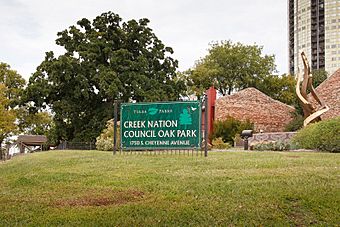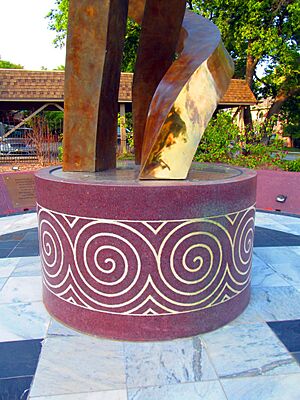Creek Council Oak Tree facts for kids
The Creek Council Oak Tree is a very old and special tree in Tulsa, Oklahoma. It marks the spot where the Lochapoka Tribal Town of the Creek Nation first settled. This settlement led to the start of the modern city of Tulsa.
The Creeks were forced to leave their homes in the southeastern United States. They traveled a long way to new land across the Mississippi River. This land was called Indian Territory back then. In 1836, after their long journey, the Lochapokas chose this big oak tree on a hill. It overlooked the Arkansas River. This spot became their main meeting place. They lit a new ceremonial fire here, using coals they had carried with them. This area became their "busk ground." It was where all important council business happened. It was also a place for tribal ceremonies, big feasts, and games. The Creeks used this site for these events until 1896. Even today, the Creeks hold a yearly celebration on October 20 to remember their arrival at this special place.
History of the Council Oak
After their arrival, the surviving Creeks built their village near the Council Oak. They named their village talasi, which means "Old Town."
People believe the Council Oak was already a big, grown-up tree when the Creeks arrived. No one knows exactly how old it is. But the same tree is still alive today in 2019! Some say it is a post oak tree (Quercus stellata). Others say it is a burr oak (Quercus macrocarpa). Both types of trees are native to Oklahoma. They are also both kinds of white oak trees.
Regular people bought the land around the tree in the early 1900s. A rich oilman named Harry Ford Sinclair once lived in a large house next to the tree. Later, a group called the Oral Roberts Evangelistic Association owned the land. They tore down the house but kept the tree safe. By 1960, it looked like the tree and its land might be destroyed to build a parking lot. But the Creek Nation and some people bought the site. They then gave it to the City of Tulsa. The city turned the land, which is about 1.86 acres (0.75 ha), into the Creek Nation Council Oak Park. Richard Thornton was chosen to design the park.
The tree was added to the National Register of Historic Places on September 29, 1976. This means it is a very important historical site. It was placed in a special Historic Preservation Zone in Tulsa in 1992. The tree was still alive in 2014.
Other Features at the Park
The park has a special garden. It shows many different plants that the Creeks used in their original homeland in Alabama. You can see a picture of the park's first planting plan on the right. It comes from the Library of Congress.
In 2008, a special monument was put in the park. It honors the Creeks' difficult journey from Alabama to Indian Territory. This journey is often called the "Trail of Tears." A Creek artist named Dan Brook created the sculpture. It shows a flame rising from a hearth, which is like a fireplace. The sculpture is called Morning Prayer.
Commemorative Painting
There is an oil painting by Mike Larsen called Creek Council Oak Tree. It hangs in the Oklahoma Senate part of the state capitol building. You can find it over the staircase on the fifth floor. A former governor named Frank Keating helped make this artwork possible. It was officially shown on March 6, 2002.




